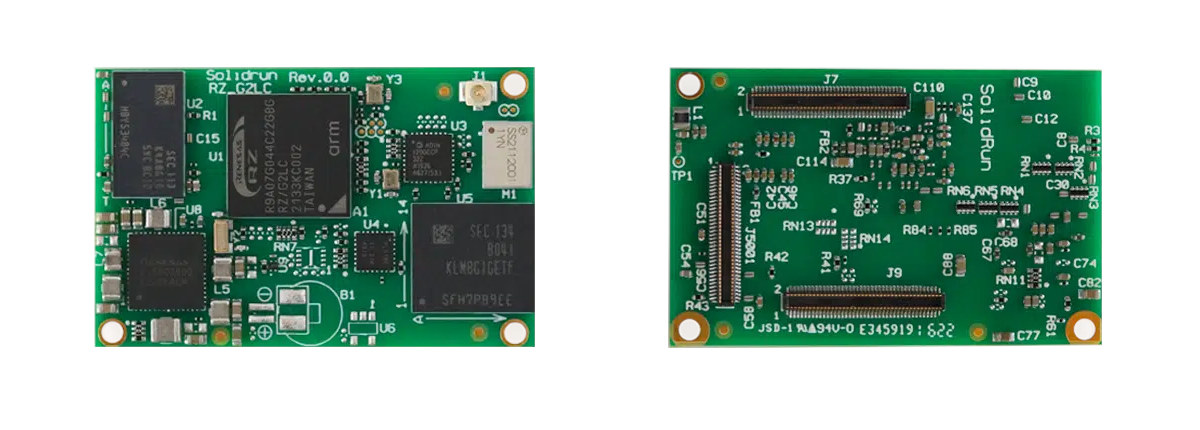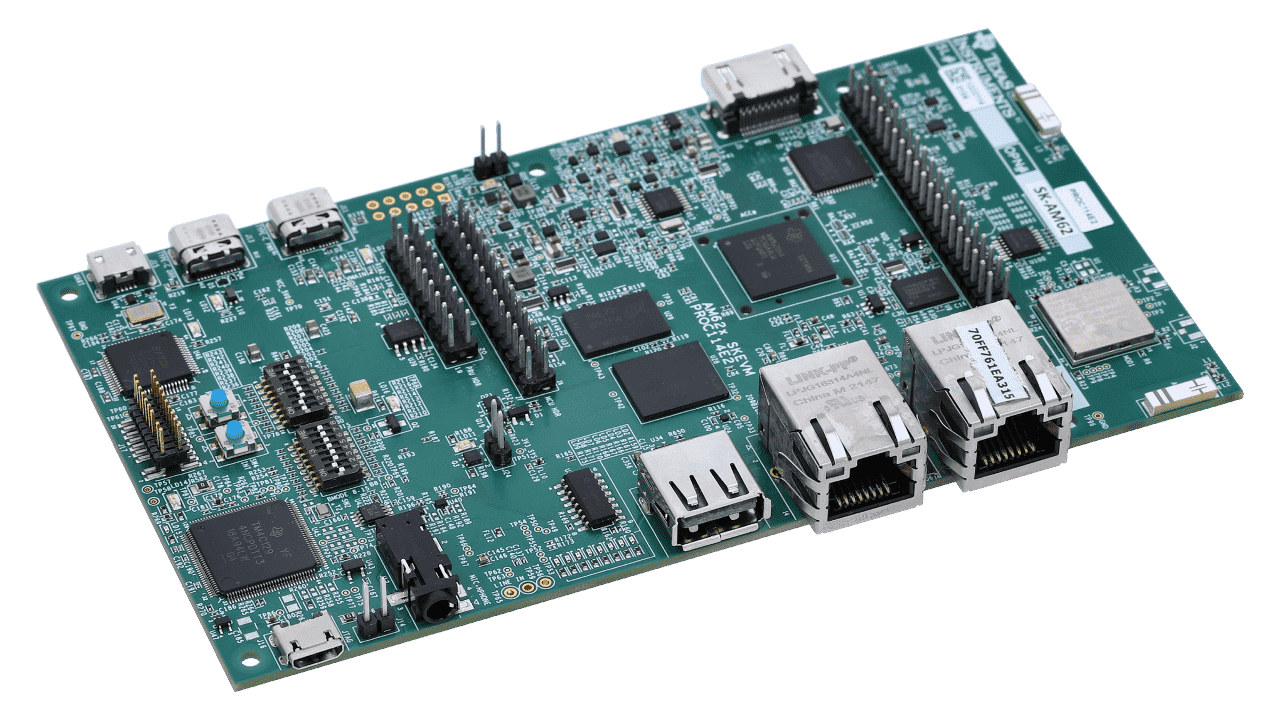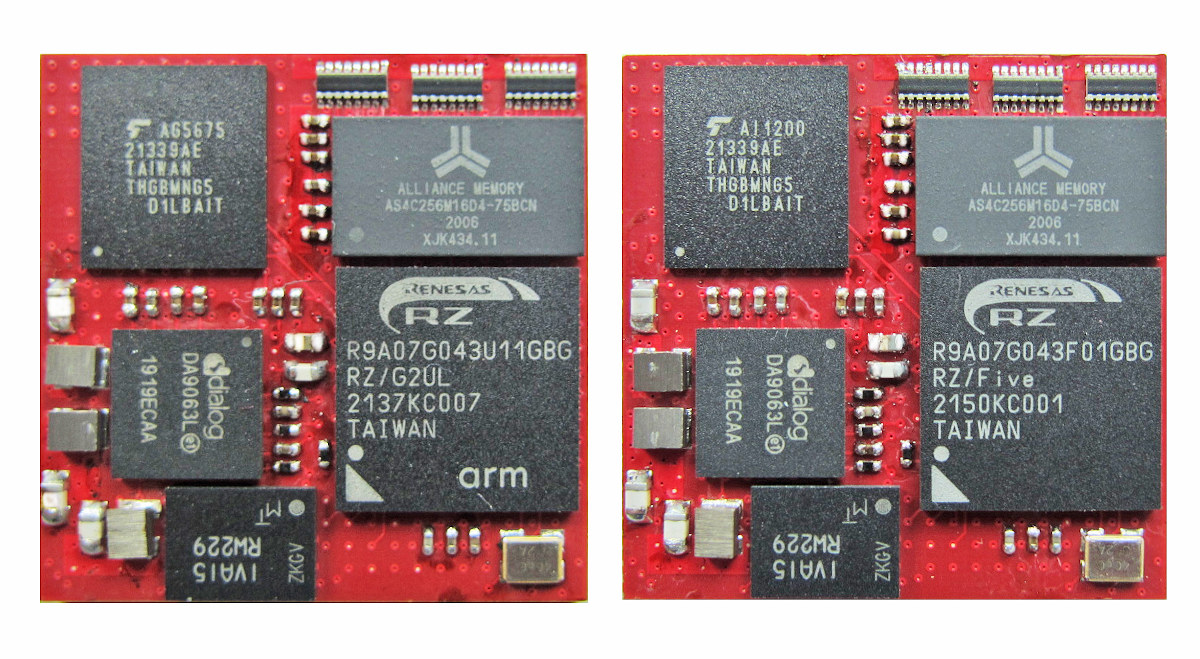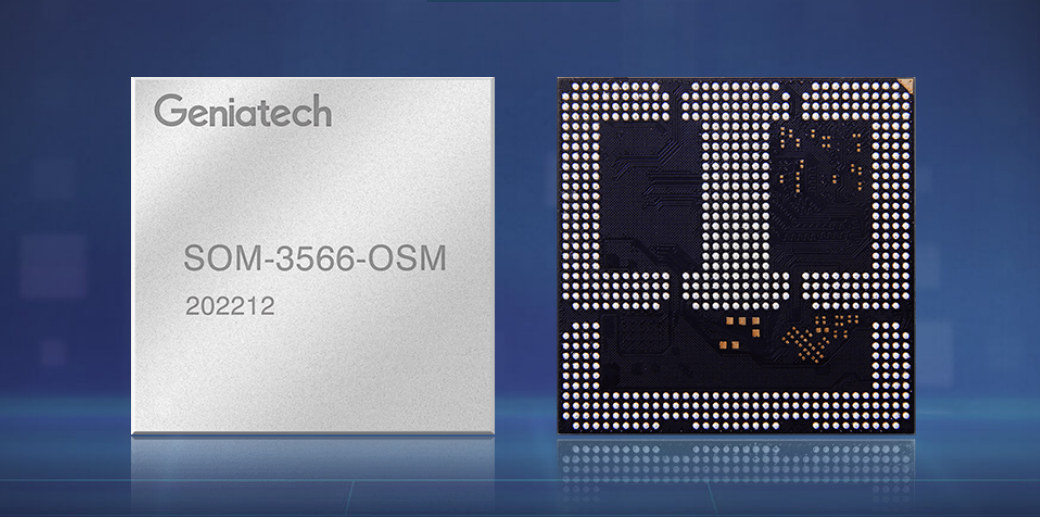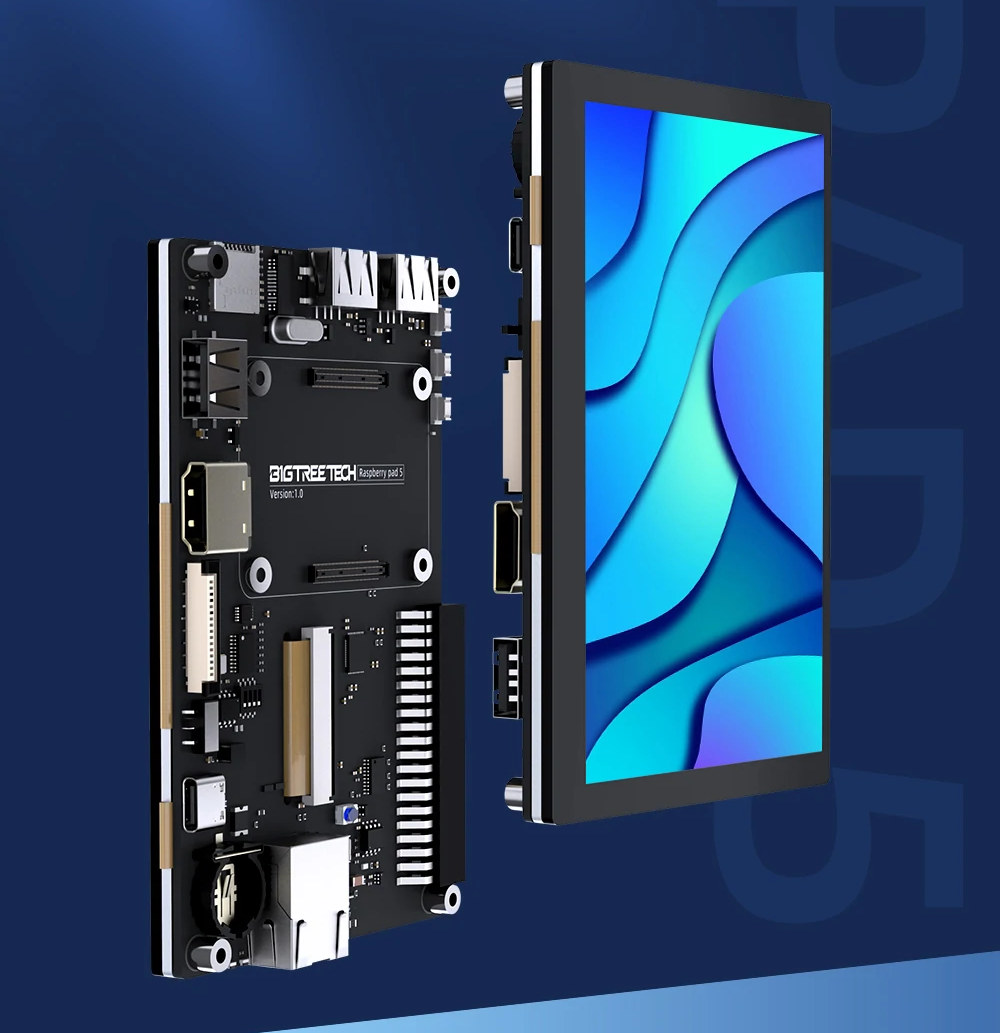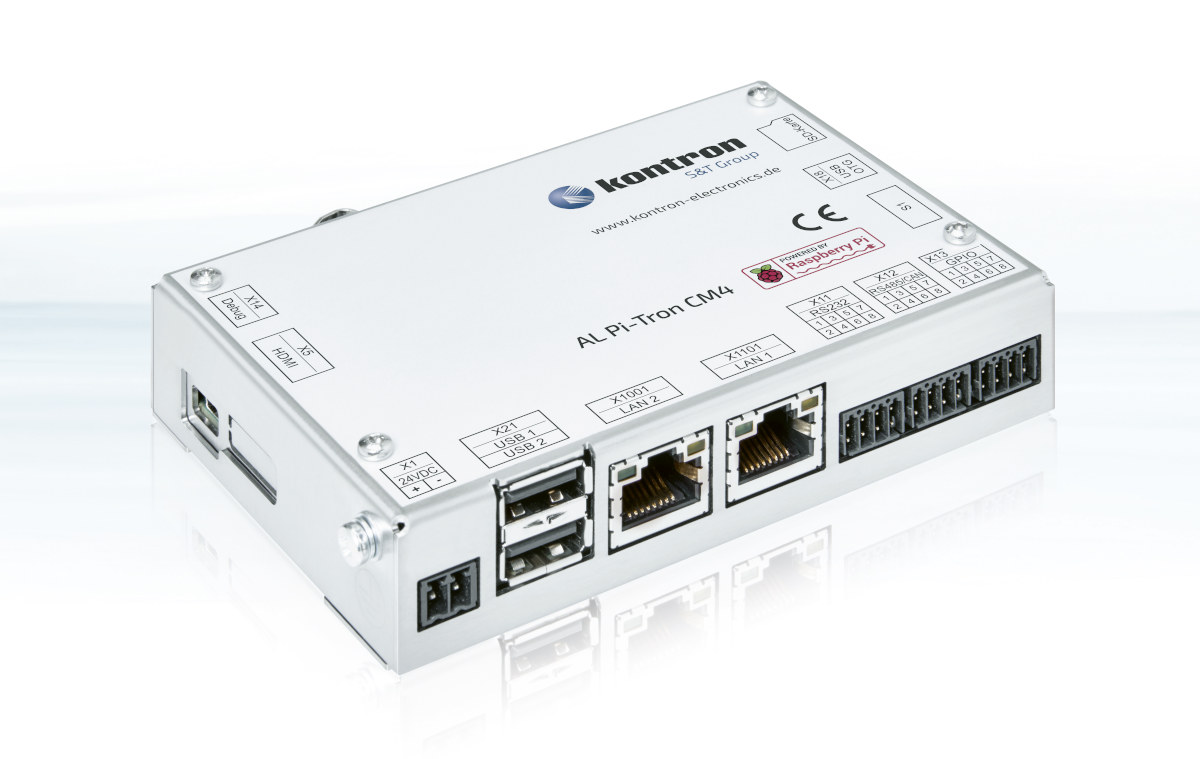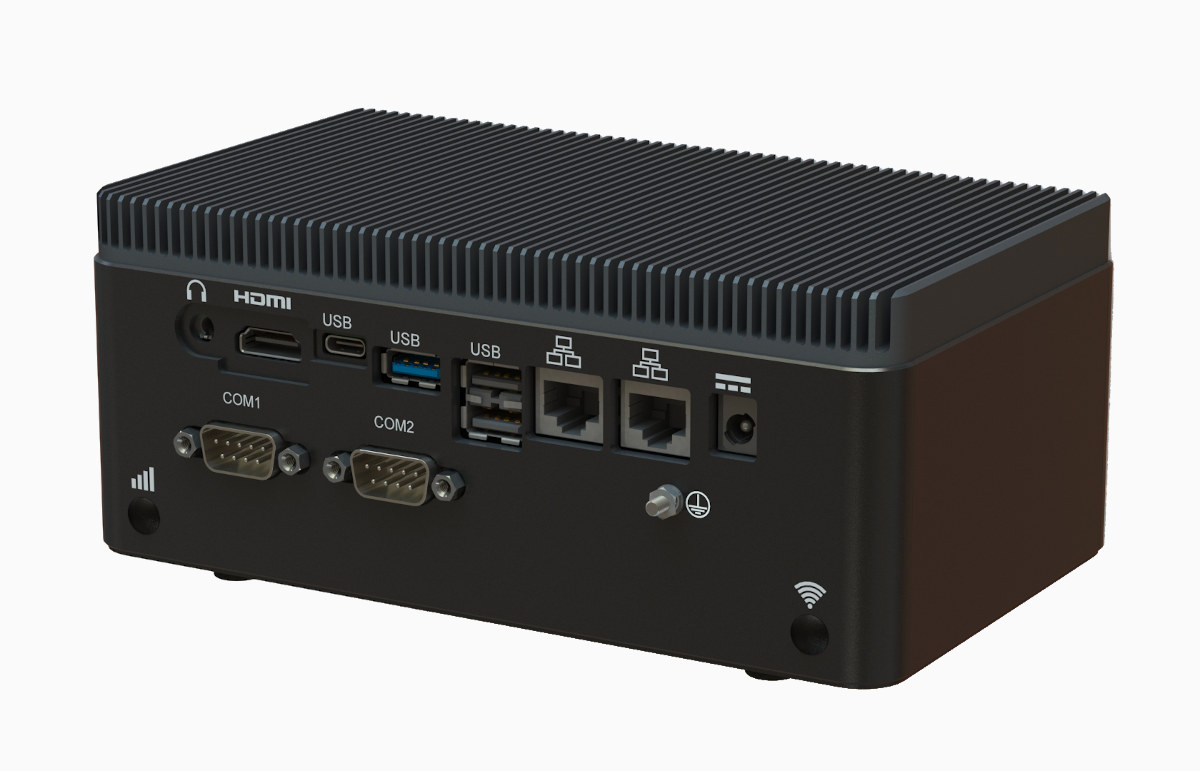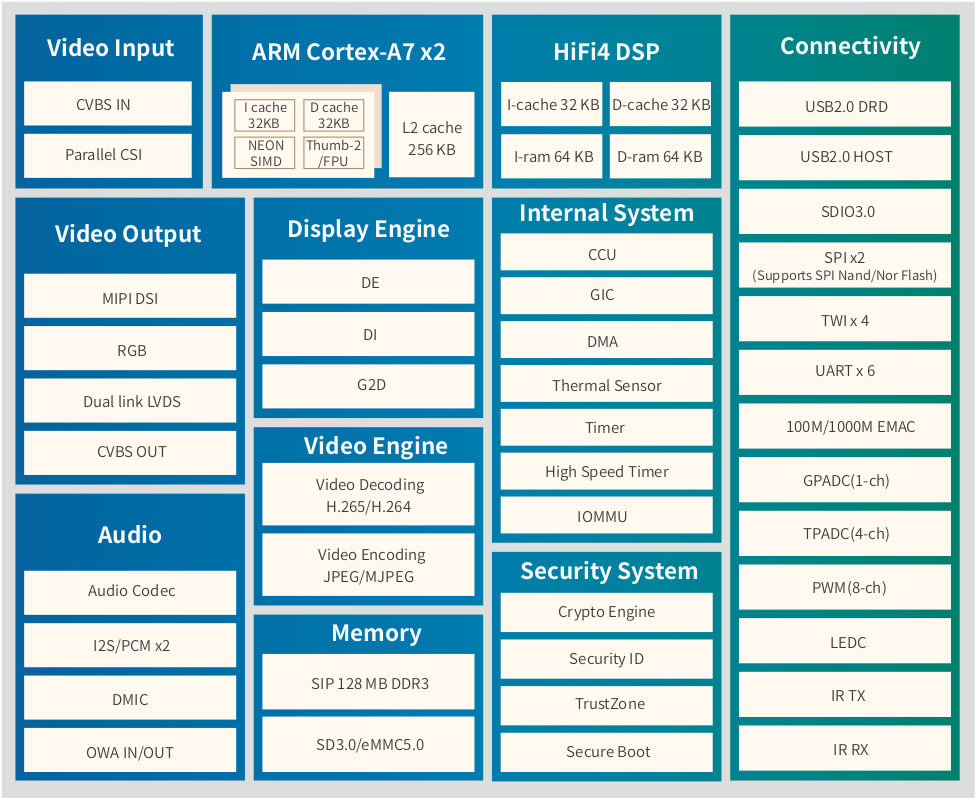SolidRun RZ/G2LC SOM is a system-on-module based on Renesas RZ/G2LC single or dual-core Cortex-A55/M33 processor and designed for AI-enhanced human-machine-interface (HMI) applications, industrial and building automation, video surveillance, IoT, etc… The module is also equipped with 1GB DDR4 RAM, 8GB eMMC flash, and a wireless module with dual-band WiFi 4 and with Bluetooth 4.2 all packed into a tiny footprint measuring just 47 x 30mm that makes it suitable for space-constrained devices such as video doorbells and compact IP cameras. SolidRun RZ/G2LC SOM specifications: SoC – Renesas RZ/G2LC single or dual-core Arm Cortex-A55 processor @ up to 1.2 GHz with, 1x Cortex-M33 real-time core, Arm Mali-G31 GPU, H.264 video decoder System Memory – 1GB DDR4 with inline ECC (up to 2GB) Storage – 8GB eMMC flash (up to 64GB), QSPI Networking Wired – Analog Devices ADIN1200 10/100 Mbps Ethernet PHY (CNXSoft remark: As shown in the block diagram below, but […]
TI Sitara AM623 & AM625 Cortex-A53 SoCs offer low-power AI for HMI and IoT applications
Texas Instruments has just launched the new Sitara AM62 family with AM623 and AM625 single to quad-core Cortex-A53 processors designed to provide IoT gateways and HMI applications with AI processing at low power, in some cases with up to 50% reduction in power consumption. The AM623 processor specifically targets Internet of Things (IoT) applications and gateways that may benefit from object and gesture recognition, while the AM625, equipped with a 3D GPU, should power HMI applications with edge AI and up to two full-HD displays. Sitara AM623 and AM625 processors Sitara AM623/AM625 key features and specifications: CPU – Single, dual, or quad-core Arm Cortex-A53 processor @ up to 1,400 MHz with 512KB L2 shared cache, plus 32KB I+D cache per core Co-processor – 1x Arm Cortex-M4F real-time core at up to 400 MHz with 256KB SRAM with SECDED ECC GPU (AM625 only) – Unnamed 3D GPU with support for OpenGL […]
ARIES Embedded unveils OSM modules based on Renesas Arm or RISC-V microprocessor
In another case of “Arm or RISC-V? Why not both“, ARIES Embedded has introduced “MSRZG2UL” and “MSRZFive” OSM compliant system-in-packages (SIPs) based on respectively Renesas RZ/G2UL Arm Cortex-A55/Cortex-M33 and RZ/Five AX45MP RISC-V microprocessors and designed for industrial controllers, IoT devices, and embedded systems with a basic GUI. Both solder-on modules come in the OSM Size S form factor (30x30mm), 512MB to 4GB of DDR4 RAM, a 4GB eMMC NAND flash, various interfaces including Gigabit Ethernet and CAN-FD, and are available in either commercial (-0°C to +70°C) or industrial (-40°C to +85°C) temperature ranges. “MSRZG2UL” and “MSRZFive” specifications: SoC MSRZG2UL module – Renesas RZ/G2UL single-core Cortex-A55 processor @ up to 1GHz with Cortex-M33 real-time core @ up to 200MHz MSRZFive module – Renesas RZ/Five single-core RISC-V AX45MP processor @ to 1.0 GHz System Memory – 512MB – 4GB DDR4 RAM Storage – 4GB eMMC NAND Flash 332 contacts with Display I/F […]
Geniatech launches OSM Size-L modules with Renesas RZ/G2L, Rockchip RK3566
Geniatech has introduced LGA system-on-modules compliant with the SGET OSM (Open Standard Module) Size-L standard and designed to be soldered directly on the carrier board. Two models have been launched with the SOM-G2L-OSM equipped with Renesas RZ/G2L Arm Cortex-A55/M33 processor, and the SoM-3566-OSM powered by a Rockchip RK3566 quad-core Cortex-A55 SoC. SOM-G2L-OSM module Specifications: SoC – Renesas RZ/G2L dual-core Cortex-A55 processor, Cortex-M33 real-time core, Arm Mali-G31 GPU, H.264 video encoder/decoder System Memory – 1GB RAM (2GB/4GB optional) Storage – 8GB eMMC flash (16GB/32GB optional) 662 contacts with Display – 1x MIPI DSI, 1x RGB Camera – 1x MIPI CSI Audio – I2S Networking – 2x Gigabit Ethernet USB – 1x USB OTG 2.0, 1x USB 2.0 host Serial – 2x CAN bus SDIO 3.0 Low-speed I/Os – 5x UART including debug, 2x I2C, 3x SPI, 3x PWM, 16x GPIO, 2x ADC Dimensions – 45 x 45 mm (OSM Size-L form […]
Raspberry Pad 5 Raspberry Pi CM4 carrier board integrates 5-inch display for 3D printers
BIGTREETECH Raspberry Pad 5 is a carrier board for the Raspberry Pi CM4 module with a 5-inch 800×480 display and mainly designed as a control panel for 3D printers, but also usable for other HMI applications. The carrier board also exposes a 40-pin GPIO header, and offers Gigabit Ethernet, HDMI video output, a MIPI CSI port for a camera monitoring the prints, a USB Type-C port, as well as three USB 2.0 ports for further peripherals expansion. Raspberry Pad 5 specifications: Compatible with Raspberry Pi CM4 and CM4 Lite modules Storage – MicroSD card slot (for Raspberry Pi CM4 Lite) Display – 5-inch IPS display with a 5-point capacitive touchscreen, 800×480 resolution Video Output – HDMI port Camera -1x MIPI CSI interface for compatible cameras from Raspberry Pi, Arducam, etc… Networking – Gigabit Ethernet RJ45 port, optional WiFi 5 and Bluetooth 5.0 (on RPI CM4) USB – 3x USB 2.0 […]
Kontron Pi-Tron CM4 mini PC leverages Raspberry Pi Compute Module 4 for industrial applications
Kontron Pi-Tron CM4 is a single-board computer and mini PC based on the Raspberry Pi Compute Module with a Broadcom BCM2711 quad-core Cortex-A72 processor, up to 8GB RAM, up to 32GB eMMC flash, HDMI video output, two Ethernet ports, optional WiFi and Bluetooth connectivity, and an M.2 slot for AI or wireless expansion. Designed for industrial applications, the Pi-Tron CM4 is also equipped with RS232, RS485/CAN FD bus, and GPIO terminal blocks, supports 24V input voltage, and is optionally sold as AL Pi-Tron CM4 in a housing suited for challenging environments. Kontron Pi-Tron CM4 specifications: SoM – Raspberry Pi Compute Module 4 (CM4) with Broadcom BCM2711 quad-core Cortex-A72 processor @1.5 GHz, VideoCore VI GPU, H.265 (HEVC) up to 4Kp60 decode, 1080p30 encode, up to 8GB LPDDR4, up to 32GB eMMC flash Storage – MicroSD card socket (only for Raspberry Pi CM4 Lite module) Display I/F HDMI 2.0 up to 4Kp60 […]
SECO PICTOR fanless embedded computer features RK3399-powered 3.5-inch SBC
SECO has recently introduced the PICTOR fanless embedded computer equipped with the company’s SOLON (previously called SBC-C31) 3.5-inch single board computer powered by a Rockchip RK3399 processor. The rugged computer ships with up to 4GB RAM, 64GB eMMC flash storage, offers dual Gigabit Ethernet, wireless connectivity, HDMI and DisplayPort (via USB-C) video outputs, USB 2.0/3.0 ports, as well as two RS-232 or RS-485 ports on DB9 connectors. SECO PICTOR specifications: SoC – Rockchip RK3399 hexa-core processor with two Cortex-A72 cores @ up to 1.8 GHz, four Cortex-A53 cores, an Arm Mali-T860MP4 GPU, and a VPU supporting H.265 10-bit, H.264 10-bit, VP9 8-bit 4Kp60 and MPEG-4/MPEG-2/VP8 1080p60 HW decoding, plus H.264, VP8 1080p30fps HW encoding System Memory – Up to 4GB 64-bit soldered down LPDDR4 memory Storage – Optional eMMC 5.1 flash, up to 64GB capacity Video Output HDMI 1.4 / 2.0a connector up to 4Kp60 DisplayPort interface on USB Type-C […]
Allwinner T113-S3 dual-core Cortex-A7 SoC features 128MB DDR3, targets automotive and industrial applications
Allwinner T113-S3 is a dual-core Cortex-A7 processor with 128MB DDR3 on-chip memory that is designed for smart control and HMI applications in the automotive and industrial sectors. At first glance, the new processor looks quite similar to Allwinner S3, but with twice the number of cores. However there’s more to it, as a a HiFi4 DSP has been added for smart audio applications, the H.264 encoder is gone replaced by an MPJEG encoder, and the company claims support for “industrial level working temperature”, plus a 10-year life cycle. among other differences. Allwinner T113-S3 specifications: CPU – Dual-core Arm Cortex-A7 with 32 KB L1 I-cache + 32 KB L1 D-cache per core, and 256 KB L2 cache DSP – Single-core HiFi4 Memory – 128 MB DDR3 Storage I/F – SD3.0/eMMC 5.0, SPI Nor/NAND Flash Video Decoding – H.264, H.265, MPEG-1/2/4, (M)JPEG, VC1 up to 1080p60 Encoding – JPEG/MJPEG up to 1080p60 […]


